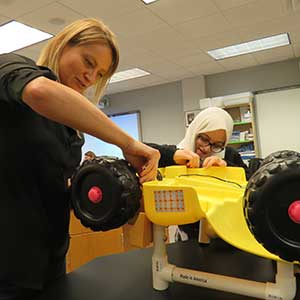Calendar Icon
Apr 10, 2017
Person Bust Icon
By Karl Vogel
![]() RSS
Submit a Story
RSS
Submit a Story

RELATED LINKS
At the Go Baby Go build and giveaway event in Omaha last October, some Nebraska Engineering students modified electric toy cars to help toddlers with mobility difficulties.
While other teams met the families who would benefit from the car they worked on, a team of five biological systems engineering students – Jordan Verplank, Zainab Alsughayer, Emmie Johnson, Hannah Jones and Ravi Raghani – were working on a car that wouldn't be given away.
Instead, as their senior design capstone project, the five engineers sought to understand the mechanics of the cars with an eye on making changes to both the circuitry and the steering that would allow the toddlers more autonomy over their own movements.
"It was very valuable for each one of us," Raghani said. "We were able to see that they could make the car go forward, but they couldn't turn it. An adult would have to turn the car for them, and that's almost contrary to the whole reason Go Baby Go exists, which is so the kids have mobility on their own."
When they returned to the lab in Chase Hall, the team began proposing and vetting design ideas that would change the design.
The team settled on replacing the giant button in the center of the steering wheel used to make the car move forward with a joystick controller that could allow the driver's tiny hands and fingers to better control the movement and steering.
Verplank and Raghani took on the controls, including even taking classes to learn electric circuitry, while Alsughayer, Johnson and Jones were in charge of the steering.
That decision, Verplank said, was when the ideas started to become more real and tangible.
"Once we decided we were going with the joystick, we realized we needed a new axle in the front and we had to program this Arduino (a microcontroller), which are two pretty hefty tasks," Verplank said.
Though the two groups worked separately most of the year, there were still weekly team meetings and plenty of communication that brought the team closer.
"We update each other on what the other side is doing and we talk about how it all fits together," Johnson said. "We are all pretty good about calling each other out when we aren't getting our work done, and we're all OK with that."
The two groups came together March 31 for a weekly meeting, where they put the circuitry and steering modifications together on the body of the "SpongeBob Squarepants" car. When Raghani pushed the button and moved the joystick, the wheels began to spin, the front axle turned without bending and the team members all shrieked with joy.
Though the second and third attempts weren't as successful, the BSE team was still satisfied with the test.
"We know it works," Verplank said. "We have to do some troubleshooting and make it work every time. Once we do that, we have to put the modification process down on paper.
"That's the next big hurdle – how do we communicate this simply to a group of people who aren't engineers. They're the ones who will be doing the renovations."
This could also mean that the Nebraska Engineering team's modifications could potentially be used by Go Baby Go projects across the country and impact the lives of even more children.
"That's helped to keep us motivated," Johnson said. "We know if we get this done, we want to do it well and not let them down."
Submit a Story

